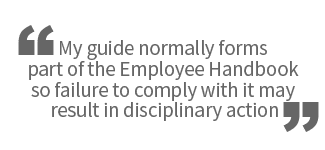When you create a social media programme it’s a great idea to get employees within your company to engage with Liking, Commenting and Sharing your content. But you have to set some guidelines or it could all go horribly wrong.
Here is my Social Media Guide that I have used at numerous companies. I normally do a presentation about who, what, why, where and how we use social media and then get the participants to sign a copy of the guide so they have agreed to abide by the rules.
The following 8-points are written in a neutral style so you can just copy and paste them into your own Social Media Guide.

1. Be honest about your identity
If a conversation relates to our company or our industry, please identify yourself as working for our company. It’s the ethical thing to do, and in some countries, it’s the law.
Best practice is to always be honest about who you are without giving away detailed personal information.
2. Make it relevant, smart and well-written
Think about your audience – it’s about what they want to read, not what you want to write. When you have found a relevant topic, be smart and try to teach them something they don’t already know.
Finally, use good grammar; it reduces misunderstanding and improves your authority.
3. Mind your manners
Treat suppliers, colleagues, competitors, our company and the wider community with respect. Please don’t post material or comments that may be seen as offensive or inappropriate.
Acknowledge differences of opinion and avoid political or religious topics. Your Manager, our customers and journalists are watching.
4. Be responsive, unless it requires official comment
Respond promptly to online requests or queries, but only if you have authority and remit. Do not portray yourself as an official or unofficial spokesperson for our company. On your personal pages please include the sentence ‘Views are my own’.
Make your Manager aware of anything potentially damaging on our social media channels before you take action – this includes negative comments about our clients.
5. Keep confidential matters confidential
It’s good business practice to keep certain topics confidential. Do not disclose non-public information or the personal information of others. Mentioning someone else in an online conversation without their permission can damage a relationship and break commercial contracts.
6. The internet remembers
Search engines and other technologies make it virtually impossible to take something back – even though there is now a ‘Right to be Forgotten’.
Be sure you mean what you say, and say what you mean.
7. New media; same rules
Be diligent in respecting intellectual property (such as copyright and trademark), financial disclosure laws, false advertising, data protection, etc.
The laws regarding libel or slander apply online and offline.
8. When in doubt, ask
If you are unsure or have any questions about what is appropriate check with your Manager before posting.
Conclusion
My guide normally forms part of the Employee Handbook so failure to comply with it may result in disciplinary action.
I also make it clear that the company may take photographs/videos of individual employees or groups of employees for social media and other marketing purposes. If the staff member does not want to appear in the photographs/videos they must inform their manager or the Marketing Department, and also make it clear before the photograph/video is taken.
Get my latest blog posts and reports delivered straight to your Inbox, just 8 times a year. It’s free but not cheap. Complete the form below to receive the Marketing Graham Bulletin; you can unsubscribe at any time.
| Marketing Graham Bulletin |
|---|
